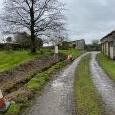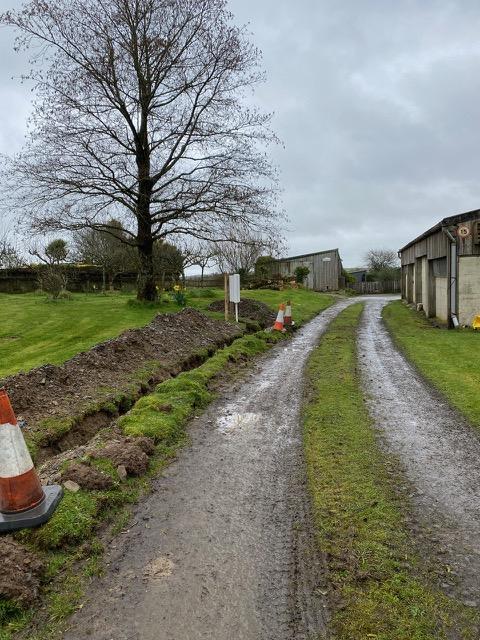-
Posts
384 -
Joined
-
Last visited
-
Days Won
1
Susie last won the day on December 22 2024
Susie had the most liked content!
Personal Information
-
Location
North Cornwall
Recent Profile Visitors
3971 profile views
Susie's Achievements

Regular Member (4/5)
183
Reputation
-
Welcome to the forum. There are quite a few of us building our home for later years. you sound like you have a lot of building experience to pass on.
-

Windows & Doors into ICF openings....
Susie replied to Mulberry View's topic in Insulated Concrete Formwork (ICF)
Norrsken measured my openings and we discussed our XPS ICF and it’s load bearing. The ICF company were happy with its capabilities but it was Norrsken who were more concerned about the installation whilst in progress. I’m not sure of the compressive strength of your ICF but it was where the packers go and point load whilst in the installation process. It is possible to push your thumb in our ICF and make a small indentation and as it’s not memory foam that small indent will stay there under the frame. Similarly the packers could push down in to ICF. Norrsken provided stokbord to sit the frames on. I EPDM before the stokbord and then taped the windows after. Were fairly coastal with high wind and rain and open to the countryside with no buildings buffering us. Windows have now been in a year I think and we’re not plastered so can still see the Icf and no water leaking in around windows. -
I have not used that one. The ones made up of two strips are good. By the time you have filled and sanded three times it will be solid. The paper actually ’soaks’ up the fill and that’s part of its bond and strength the metal strips take the knocks more but might have less bond as they can’t soak the fill the same. Looks like it has little perforations which is good. I know some prefer the paper tapes without the metal because the perforations allow good contact with the fill. If you are doing the filling yourself can you have a go with a sample piece and see which you like the best. It’s also handy to know where you can buy from when you run out, as you say online can be quick as can Wickes who sell Knauf and SF and TS. PM me if you want a small section of the paper tape with the two metal strips.
-

Correct Gullies / Traps / Hoppers for Rainwater System
Susie replied to MortarThePoint's topic in Rainwater, Guttering & SuDS
Are you concerned about leaves? I’ve used something like this. FLOPLAST PUSH-FIT DEBRIS GULLY 110MM (25121) My rainwater also goes to a soak away that has a bottle trap/bucket before it as well. I can’t say how good it all works as not been up long enough yet. -
Used these on my plant room, and happy with them to use again, would also consider using them for a vaulted ceiling to wall internal corner on my next room. It’s also dependent on the fill you do, how many fills and how many sands.
-
Sounds like it’s Utility company now so that’s good. Could be something in the deeds of neighbours but doesn’t sound like it matters any way. good luck on SUDs. You will probably have to dig a pit and prove you don’t drain away enough but your local BC may advise what others are doing locally.
-
Do you know how old the pipe is that runs through your garden? ’In England and Wales, private sewers and lateral drains became public on October 1, 2011. This legal change, enacted by the Water Industry (Schemes for Adoption of Private Sewers) Regulations 2011, automatically transferred the ownership of these privately-owned pipes to water and sewerage companies.’ if they are older than 2011 they are now considered to be public but the water board just don’t know they exist or the route they follow. Importantly if older than 2011 and they get a blockage then the water board unblock them as they are no longer private. if newer than 2011 they are private but will join the public sewers some where so you would need permission from the private owner most likely who ever is furthest up stream to join their sewer but also will possibly still need to notify water board as you are adding to the volume of water in their pipe unless it all goes to a private ditch or pond.
-

Consumer unit replaced. Certs needed?
Susie replied to BotusBuild's topic in Consumer Units, RCDs, MCBOs
You definitely should have received a certificate if you still have some of the details of who did the installation you can look them up on NICEIC if registered with them or other part P registration schemes eg ECA and if you find who they are registered with then you can contact the registration scheme who will organise it to be checked. All the registration schemes guarantee the work of the members that’s why the annual checking of the members is done. As Nod said when the annual checks are done it is often at least a full day of inspecting previous jobs and checking paperwork and insurance is in place. Being a qualified electrician getting the certifications from college etc is not the same as being registered with a part P scheme provider as your work or company work is continually checked. -
https://simplybamboo.co.uk https://www.bambooflooringcompany.com these are the big 2 companies, other flooring companies might have one or 2 bamboo plank options, eg Wickes has at least one double up on the free samples by getting delivered to multiple homes if necessary. They don’t hassle you afterwards. They also do skirting to match and door thresholds etc
-
Have you considered bamboo flooring, can be glued down or loose lay, UFH is ok, some are 2x harder than oak and can be sanded if necessary. Uniclic edges, non slip, and UV coating, warm under feet. we have a dog who loves to run up and down hallways, and do that stretching out of legs with toe nails ready to mark floor. Only had samples so far but seem good option for us.
-

Toilet into vent stack/Alternative to vent stack?
Susie replied to Del-inquent's topic in Waste & Sewerage
You can get external AAV https://www.floplast.co.uk/article/external-air-admittance-valves -

Cladding Complete, drainage in and general update
Susie commented on Susie's blog entry in The Old Cow Shed
Looks like you will definitely be moving in before us though. 😀 -

Cladding Complete, drainage in and general update
Susie commented on Susie's blog entry in The Old Cow Shed
Ground workers collected their digger today and we have sown some grass seed just to cover the ground a bit. It is nice to see the finished levels, around the house. David has compacted some hardcore so we only have a small step to enter the house now. Our list for inside is still huge as you know. -
Weeks 40 to 56 So it’s been a year now since we started the build and I’m happy with our progress but perhaps more importantly I’m still enjoying it. If you have followed the blog from the beginning you might have thought this was going to be a quick build as the shell went up quick but don’t worry work is continuing as we expected at our own slower pace, we have no definite finish date but it would be nice to be in for winter next year. The cladding is finally complete. David started the cladding at the end of March and I think it’s fair to say it took him a lot longer to complete than he expected, but like me he likes to get the details correct ie drip angles on bottom edges etc and neat finishing around the doors and windows. The photos show how the Thermo Pine has already started to fade. We are happy with the colour changes it is greying nicely and hopefully will blend in with our working barn after another summer. Above is a sample piece that has not been exposed to the weather and the other image shows the first signs of the greying colour change. This is our working barn the wood on here is a minimum of 20 years old more likely 40 years old. Inside I have completed most of the insulation above ceiling height, we have slopping ceilings in 2/3rds of the building that will be completed after the screed is done. The MVHR ducts are in the roof, I carefully insulated around them as they pass through the Rockwool layer and the Celotex, then the VCL layer which is Gerband SD control. Not the most expensive VCL but still a reasonable price for a control layer. Putting the VCL up on my own was tricky I used double sided tape to attach it to the Celotex initially pressing it on top, middle and bottom as I unrolled it for 12m. This held it in place surprisingly well leaving me ample time, (days as it often too hot to work in the loft) to tape it up properly with Gerband airtight tape. I finally took a break from the roof insulation and moved on to floor insulation which is a much nicer job on my knees. Back in June we had a Cornwall/Devon meet up of fellow build hubers. It was great to put a face to the user names. The weather had one quick shower just as some arrived but then cleared up so that we could all sit around eating pizza and chatting. The waste for the two wet rooms is completed ready for the screed. I’m now ready to lay the UFH separation layer for this I have chosen something a bit different https://www.laminon.co.uk/. The material is a bit like weed membrane which if any body has ever pegged down knows how those pegs don’t want to come back out easily. It also has a grid marked on it that might make it a job for me on my own, together with the decoiler and stapler I have borrowed, or David will help me. Like many on here I downloaded LoopCad, input all the data about my location and the build then designed the loops. For reference I used the Ashrae load calculation method, rooms that didn’t need UFH e.g. the pantry I input as already having a heat source. I have kept my results and all the print outs but in the end I have chosen Wunda because they are very competitive compared to me buying the manifold and pipe from an online UFH trade shop. They have saved on their costs because they can send the coils out in lengths more compatible with my circuits e.g. I have 5 circuits between 109m and 117m so they can send out 5 x 120m coils. No matter how I combine different circuits I always ended up with a lot of wastage pipe. They don’t use LoopCad to its full extent e.g. the whole house modelling for the load calculation but from what I discovered most UFH suppliers don’t either so I might need my LoocCad summaries for the flow rates as Wunda are not accounting for a well insulated and air tight building. They are for now not supplying the pump or any thermostats as our plan is to get the house fully insulated and the VCL layer completed on the at least most ceilings so we can monitor the room temps with a few data collecting thermometers. This will hopefully tell us how cold its going over winter without occupation, and so far its certainly feels warmer than our current house. We now have drains connected to the main sewer line and our soak away is installed. Next job will be the guttering. I had to take down my potting shed for the build but hopefully next year I can reassemble my potting shed in its new location which is the opposite side of the cow shed than it was previously, but my view is a lot nicer. I also finally finished the Gabion wall, I used all our own stone and rubble. Most of the stone was from the initial groundworks that we had moved down to the lower field. This meant that I took the lawnmower and the garden mini dumper down there, climbed the piles and picked out the best stone and brought it back up to the house. When I was nearly completed and I knew the groundworks team would be returning for our drainage connection and soakaway I decided to wait for them to hopefully unearth some more nice stone. They did but I had to work fast to use it before it was back in the ground around the house getting the levels correct. There is still a lot of stone in spot on the lower field but for now I don’t want to build any more Gabion walls. Of the trades people we have had on site so far the groundwork’s have been the best and I would be happy to recommend them. To the left of the photo is the old stables you can see how this wood is aged, hopefully our Thermo Pine will age similarly and blend in. The photo above was taken just after the Groundwork's finished for the day, you can see the mist has blown in and the cladding looks different again when wet. The following day and we can see how great a job the groundworkers have done, its hard to believe this is the same soil I have picked the stone for the Gabion walls from. They sorted the soil with the digger and buried the bigger stones leaving quite good soil on the top. They are returning next week with a bigger dumper truck to bring the soil back up from the lower field. They will then fill in the bit to the right of the photo and round the front.
-
We are waiting to see what it’s like over winter. we are XPS ICF, 200mm insulation in floor and 200mm in roof, triple glazed and a basic rectangular shape so should be very good airtight. We will have heated towel radiators in both bathrooms and wood stove in open plan kitchen, lounge. Add to that were in Cornwall and haven’t had a frost last year or seen snow for a few years now. The back up plan is the Willis system, leaving space and planning this. I designed it on loopcad first then I told Wunda what I wanted.




